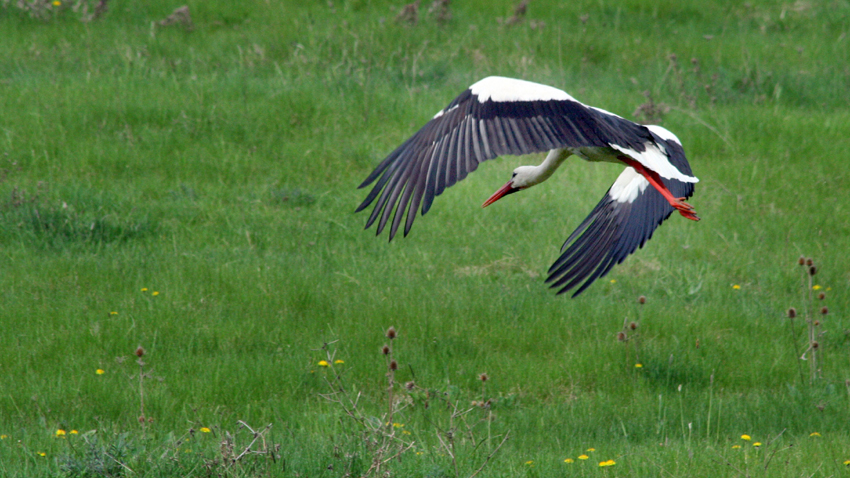The stork is probably the most popular, or at least the most beloved big bird in Europe. These beautiful white birds are characters in many stories and legends and are symbols of springtime. The silhouette of the bird strolling in the fields can be seen in quite a number of paintings. But the industrial revolution made the number of storks decrease sharply on the old continent especially so sometime later - during the 20th century. This alarming fact made environmentalists worry and in 1934 the first global census of the white stork was held. Since then it repeats every 10 years. The census is organized by BirdLife International - a network of over 110 environmental organizations from all over the world. Bulgaria was included in this global monitoring in the 70s of the past century. From June 15 to July 10 this year a new census is conducted in this country by the Bulgarian Society for Protection of Birds /BSPB/. The counting will continue during the same period next year. A decline or rise in the population of the white stork is an important indicator of the quality of the environment which we all live in.
The largest global monitoring of the stork is underway. Luckily, the implementation is relatively easy, as the white stork is easily recognizable. Even children can participate and they do it with joy, counting the birds’ nests. The monitoring will also identify the threats to the storks. During the years threats have proven to be industrialization, monoculture and the extensive use of chemicals in agriculture, as well as the loss of wetlands, where storks most often look for food.

What were the results of the previous stork census in the country?
In 2004, storks in Bulgaria were nearly 5,000 pairs and hatchlings were 12 500 says Svilen Cheshmedjiev, campaign coordinator in the country.
"This is an average level for a European country,” he added. “Bulgaria places 10 -11th in Europe when it comes to the population of these birds. Most storks nest in Poland, where 46,000 pairs were counted. In Bulgaria the greatest number of storks can be seen in the regions of Plovdiv, Haskovo, Sofia and Pleven. In the region of Plovdiv we counted 486 pairs of white storks last time. The village with most nests was Dragushinovo near Samokov with 36 pairs of nesting storks. The town of Kozloduy follows with 27 pairs and the town of Saedinenie comes third with 26 pairs.”
Storks increasingly nest on electric poles, rather than trees.
Abrupt changes were observed between the censuses in 1994 and 2004 and the cause is known - the lack of large trees suitable for nesting. More from Svetoslav Spassov of BSPB:
"Most nests (about 3900) were on electric poles; there were about 950 on buildings, roofs, chimneys, schools. There were only 680 nests on trees, as storks prefer mulberry trees and oaks. "
Apparently the love between humans and storks is mutual, because most of these birds prefer nesting near humans. Just 10 percent of them nest in completely depopulated areas in Bulgaria.

What results are expected from the ongoing census?
It is difficult to predict the trend, expert Svetoslav Spassov says.
"In the period 1994 - 2004 we registered 18% increase in the population of the white stork. We assumed that was due to the collapse of intensive farming from the times of communism. Collective farms counted on monoculture and serious use of pesticides. This naturally ended in the 90s with the collapse of socialist agriculture planning. Biodiversity increased as well as the sources of food for the storks. But now European subsidies are provided for agriculture and grasslands disappear. It will be interesting to see how this has affected the population of the white stork.”
What does the periodic monitoring of other field birds show?
"In the period 1995 - 1997 the number of field birds increased but the trend reversed after 2010. We cannot say yet what the situation with the white stork is. The bird is associated with a particular habitat - wetlands and it is possible things are different there.”
English: Alexander Markov
He does not accept the definition of "apostle" or "missionary", although for many he is exactly that - a messenger of God in the world, proclaiming His Word. He first became a priest in his native Vidin diocese, in Northwestern..
Over 80% of Bulgarians are expected to start using artificial intelligence in the next three years , across all age groups. Today, it is almost impossible to find a Bulgarian student who does not turn to ChatGPT when preparing homework. This..
Serbians around the world mark one year after Novi Sad tragedy On November 1, Serbians abroad will join the call of students in Serbia to mark the anniversary of the collapse of the canopy of the Novi Sad railway..
Forty Bulgarian schools in 22 US states have become a second home for the children of Bulgarian emigrants. They create continuity..
A case of a dog run over by a doctor in a district of Sofia has caused a wave of public indignation and a protest in Sofia, which will..
A Bulgarian-designed electric vessel has gained international recognition , reaching the final round of the prestigious Gussies Electric Boat Awards 2025 ...

+359 2 9336 661
